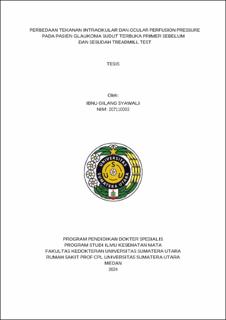Perbedaan Tekanan Intraokular dan Ocular Perfusion Pressure pada Pasien Glaukoma Sudut Terbuka Primer Sebelum dan Sesudah Treadmill Test
Difference of Intraocular Pressure and Ocular Perfusion Pressure in Primary Open Angle Glaucoma Before and After Treadmill Test

Date
2024Author
Syawali, Ibnu Gilang
Advisor(s)
Sari, Masitha Dewi
Sitepu, Bobby Ramses Erguna
Metadata
Show full item recordAbstract
Background: Glaucoma is one of the leading cause of irreversible blindness in the world. Intraocular pressure (IOP) and ocular perfusion pressure (OPP) remains as the most influential modifiable risk factor for glaucoma progression. IOP and OPP may be influenced by exercise and can be utilized to control IOP and OPP in glaucoma patients. This current study aims to analyze the differences of IOP and OPP in primary open angle glaucoma (POAG) patient before and after treadmill test.
Method: This study used pretest-posttest control group design. Subjects aged 40 years old or older will be divided into 2 groups, POAG and control group. Measurement of IOP and OPP was performed prior to treadmill test, and 0 minute, 30 minute, as well as 60 minute after treadmill test. The exercise was performed using treadmill machine using the speed of 4 km/hour and 0% inclination for 10 minutes with moderate intensity.
Result: Forty subjects that fulfilled the inclusion criteria was recruited in this study, specifically 20 subjects in POAG group and 20 subjects in control group. Mean baseline IOP in POAG group was 18,49 mmHg and in control group was 13 mmHg. After treadmill test was performed, IOP measurements in the 0, 30 and 60 minute in POAG group showed a significant decrease, measured at 16,19 mmHg, 15,71 mmHg, and 16,44 mmHg (p<0,001), respectively. For the control group, significant decrease in IOP was also noted in the 0, 30 and 60 minute after treadmill test, measured at 11,85 mmHg, 11,11 mmHg, and 12,07 mmHg (p<0,001), respectively. On the other hand, mean baseline OPP in POAG group was 39,88 mmHg and in control group was 43,71 mmHg. After treadmill test was performed, measurements in the 0, 30 and 60 minute in POAG group showed a significant increase in OPP, measured at 49,2 mmHg, 49,25 mmHg, and 47,74 mmHg (p<0,001), respectively. For the control group, significant increase in OPP was also noted in the 0, 30 and 60 minute measurement after treadmill test, which measured at 51,65 mmHg, 52,4 mmHg, and 49,95 mmHg (p<0,001), respectively.
Conclusion: This study revealed a significant decrease in IOP and increase in OPP after moderate-intensity treadmill test in the 0 and 30 minute examination. On the 60 minute examination, the effect of decreasing IOP and increasing OPP started to diminish and returned to its near baseline value.
Collections
- Master Theses [145]
